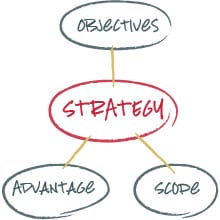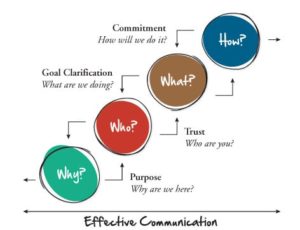A clear business strategy is a crucial strategic tool for any organization that wants effective action where it matters most.
Virtually all professionals – from frontline to boardroom – know the frustration and disappointment that results from not having a clear strategy. Without it, there is nothing to inspire powerful decisions or align efforts across the organization.
Yet, the majority of organizations cannot articulate a clear, believable, and actionable strategy for growth or impact.
There is more to it: Such a strategy must be articulated succinctly and consistently across all functions. Strategy statements that are too long are less powerful. Those that produce a variety of responses are ineffective. The most effective strategy statements are memorable and not open to interpretation.

With a clear strategy statement, however, each member of the organization has a north star to align decisions and actions. Everyone moves forward together. Individual contributions are purposeful, not wasted, and, therefore, the individuals themselves don’t feel left behind or ineffective. Everyone is working in concert.
Additionally, a clear strategy statement offers “anchors” – a shared set of boundaries, priorities, and means – that allow coordination across functions so members of different teams can build on each other’s contribution.
Room For Improvement And Effective Leadership
Yes, many organizations have an awareness of big change initiatives, annual and 5-year financial targets, a hopeful view on what “differentiates us” and what “should” give us a win in the market. But key strategy elements remain vague, are not bought into, or money isn’t put where the mouth is, e.g., “If we want to be known as easy to do business with, why do we use complicated automated service hotlines?”
Effective strategic execution requires a clear strategy and strategic alignment across stakeholders.

Source: Gibb-Drexler-Weisbord
Often, the lack of a cohesive strategy or poor strategic alignment across functions is most strongly felt by the people executing the plan. That can make it tempting to push for more granular project planning at the front lines. But increasing alignment needs to start at the top.
There is a fundamental “hierarchy of questions” that require satisfactory answers before better planning can occur. Leadership needs to address the big questions of purpose, vision, and priorities. Once everyone is on the same page, branching out into detailed planning can be done swiftly.
Precise Planning In Critical Moments
Many organizations review and revise their strategy in regular cycles, usually every few years. But often discussions about strategy and strategic alignments are triggered during pivotal moments, such as:
- When business flags or business-as-usual is no longer an option
- The high growth of the business meant everyone was busy responding to the scaling challenges without making time to step back and think through a fundamental blueprint and related priorities for the evolution of the company
- A change in leadership where a senior leader takes the helm – usually on a division/business/executive level
- During a succession and related onboarding process where a parting leader or founder of the organization passes the baton to the next generation of leadership
The stakes are high. There is little room for ambiguity or trial-and-error. Doing the hard work of answering tough questions, turning instincts and business data into paradigms for success, and making sharp and defining choices to achieve the desired result will, in the end, manifest into a more synchronized environment where real work is getting done.
We find that coaching leaders and teams through such pivotal moments can facilitate true alignment more easily than many would envision and have greater outcomes than anticipated.
Two Simple Questions
Strategic alignment and cross-functional alignment require candid answers to two key questions:
- Can we say it?
Can we express our strategy in a clear and consistent manner? Can we articulate our competitive advantage, priorities, goals and next steps in the same manner? Are we clear about boundaries, i.e. what we say yes or no to? Do we make such decisions quickly and with consistency? Are we all on the same page? Do we believe what we say? - Are we disciplined enough to live it?
Is our defined strategy something we can actually carry out? Are we focusing on what we say we are best at? Are we willing to invest in the capabilities on which our strategy relies? Does every employee have the resources they need to achieve this goal? Has everyone shared their input, felt fully heard and ready to carry out the plans? Can we internalize this strategy?
The classic example is Southwest Airlines, which successfully focuses on select differentiators (e.g., few hubs, one type of aircraft, no reserved seating). Other airline’s copycat attempts didn’t create the same level of success because they didn’t live the strategy as consistently as Southwest. It takes a good concept and the discipline to live it. That’s where strategic alignment comes in.
The Perfect Environment For Making Hard Choices
This simple task is not necessarily easy. Each functional leader invariably has a different viewpoint and creating a cohesive, representative story from the many perspectives requires give and take from each of the constituents.
From a pure business perspective, these questions can be arduous to answer because they involve predictions, assumptions, and risks. There are sunk costs to consider: reputational, financial, and motivational. There is uncertainty.
In addition to the business complexity, stakeholders can have emotions tied up in making these decisions.
Also, people have different appetites for risk-taking, e.g., their appetite to “go all-in” on an opportunity to differentiate their value proposition.
So it’s not only the complexities of planning and predictions that make strategy work daunting; strategy discussions involve a considerable human element.
A clear process for defining strategy and strategic execution supports groups to move through the technical and emotional challenges. This process, facilitated by the coach or consultant, ensures that the meetings will be both efficient and effective. It allows for safe, focused, essential, conversations. These conversations, methodically nurtured by a coach, allow everyone to become more emotionally, mentally, and strategically aligned with the direction they are setting for the organization.
The coach or facilitator must make certain the group is having the necessary conversations, in the proper sequence, to create forward motion. It is essential they create an atmosphere that makes it safe to bring up and solve critical questions so there is no wasted time and effort. This process eliminates potential problems and clears the way for the entire organization to begin working toward shared goals.
Coaching Pinpoints The Problem
Strategic alignment often fails when the stakeholders are unable to have candid conversations about the processes or problems that may arise from the newly proposed strategy. Poor group dynamics or a lack of psychological safety are often to blame for such breakdowns; stakeholders or employees don’t feel empowered to speak up about possible roadblocks or misunderstandings may arise. These issues often cannot be fully resolved without a coach or other third party consistently advocating for clarity and alignment.
The head of client services may know, for example, that her understaffed department is unable to support the new strategy of “easy returns in one week or less,” but goes along with the group and vows to herself that she’ll figure it out somehow. With a coach present to ask the critical questions of each department (“Do we have the discipline to live what we say?”), such concerns and potential problems are explored and solved before they ever threaten the vitality of the plan.
Benefits: Living The Strategy
Strategic alignment would not be worthwhile without reaping results. While the objectives and outcomes may vary from organization to organization, increased alignment brings some universal benefits that create huge wins:
Visions become fully realized. With facilitated conversation, the usual group dynamics are surpassed and each member gets to fully voice his/her opinion, goals, objections and ideas. The typical “know-it-all” is asked to press the pause button so all members get say in the direction of the firm. Insights from the “quiet observers” of the group are drawn out and examined equally with all other ideas. Everyone has input, agency, and accountability so the group vision can become a reality.
Departments/Functions become owners. When the orders from leadership are clear and believable, each of the staff members has the agency to act on behalf of the company’s greater good. Strategic alignment energizes and empowers the entire organization. When management and staff members are working from the same playbook, with the same words, priorities, goals, and vision, “it allows everyone in the organization to make individual choices that reinforce one another, …employees become exponentially more effective,” (Can You Say What Your Strategy Is? Harvard Business Review, April 2008). In effect, this kind of strategic alignment takes disparate actions and decisions made company-wide, and points them in one specific direction, with one point of focus. This kind of alignment is what truly enables powerful execution.
Put up guardrails. The strategy that results from strategic alignment workshops gives each employee an action plan that leaves no room for misinterpretations. Each member of the organization can use the strategy as a definitive guide for making decisions. This process brings immense focus to the work that needs to be done and empowers individuals to contribute in a meaningful way to the success of the organization.
Clarifying your strategy statement and using the process to simultaneously increase strategic alignment is a powerful way for any organization to increase impact, competitiveness, and growth. Too many organizations get caught up in the details, stall because of interpersonal dynamics or go off on numerous tangents that only lead to circuitous conversations. We have found an effective way to facilitate safe, essential and focused conversations that lead to a consensus. It is this consensus that creates strategic alignment, enthusiasm for the vision and discipline around decision making so the organization can move forward together in a deliberate and powerful way.
Combining organizational and individual psychology, Collaborative Coaching coaches leaders to be more conscious in their leadership and helps teams to interact more authentically in ways that enhance trust, aliveness, collective problem-solving, and aligned action.

